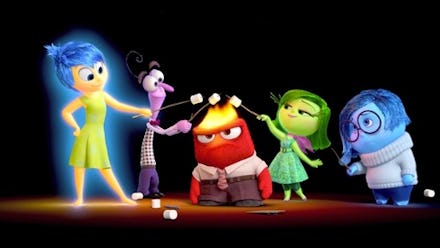The Disturbing Trend in Almost Every Female Pixar Character

Though it won't be released for months, Pixar's next movie, Inside Out, is already generating plenty of buzz. Disney and Pixar have offered some impressive, fantastical female protagonists in recent years, but what makes Inside Out different is that it features the complex interior life of a normal girl.
There's just one problem: Stills of the movie reveal that Inside Out may have fallen victim to Pixar's unfortunate trend of making all its female characters look almost exactly the same.
One Tumblr user noticed this while studying an image of several characters from the film this week. Familiar with debates about Disney/Pixar's aesthetically homogenous characters — deemed "same face syndrome" by another Tumblr user — the user, identified as Alex on her blog, decided to put the newest film to the test.
She traced the faces of this film still:
And found that while the purple and red male characters were afforded diverse face shapes, the remaining female characters were strikingly similar:
Disturbed by these findings, she decided to scale the project to include a number of Disney/Pixar characters:
Lo and behold, the trend held across multiple films:
"Apparently every Disney woman is a clone/direct descendant of some primordial creature with huge round cheeks and a disturbingly small nose, because there is no other explanation (yes there is; it's lazy sexism) for the incredible lack of diversity among these female faces," she wrote.
Alex also lambasted an animator who stated that animating female characters is "really, really difficult," because they have to remain "pretty" while still going through a "range of emotions." She then suggested that Disney "stop assuming every woman has a round baby face and a short cute baby nose."
While these images are certainly striking, the homogeneity of female characters is hardly news. In December, for example, BuzzFeed conducted a census of Disney female characters and found that most leading female characters were younger than 20 years old, 71.4% were white and that 57.1% were married or about to be by the end of the film. Beyond the lack of diversity, plenty have also noted that many Disney films perpetuate racist and sexist ideologies.
Ultimately, this uniformity is about more than a lack of creativity. Studies show time and again that media representation of women matters: Female characters can affect the self-conception of young girls in a very real way. Disney and Pixar missed an invaluable opportunity to actively instill positive values about diverse beauty in their young female viewers.
It's certainly commendable that, at least in the case of Inside Out, Pixar seems to be attempting to discard one-dimensional narratives about female characters. But in order to execute this mission completely, they must follow through in terms of presentation as well. Restricting female characters to normative beauty standards undermines their potential to not only support the girls who deserve to see themselves on screen, but also to remind everyone else that female characters should be fully-realized and unique.